The pituitary gland is located in the skull in the bony sella turcica under a layer of dura mater. It is divided into three lobes: an anterior lobe, a posterior lobe, and an intermediate lobe. The anterior lobe produces stimulating hormones in response to hypothalamic stimulation. The pituitary lobe stores ADH and oxytocin. The intermediate lobe produces endorphins and enkephalins to modulate pain perception.
Pituitary agents include drugs affecting anterior (further divided into growth hormone agonists and growth hormone antagonists) and posterior pituitary hormones.
Drugs that affect anterior pituitary hormones mimic or antagonize the effects of specific pituitary hormones. They are used as replacement therapy, for diagnostic purposes, and for blocking the effects of anterior pituitary hormones.
The anterior pituitary hormone that is most commonly used pharmacologically is growth hormone (GH).
Table of Contents
- Pituitary Agents: Generic and Brand Names
- Growth Hormones Agonists
- Growth Hormone Antagonists
- Drugs Affecting Posterior Pituitary Hormones
- Practice Quiz: Drugs Affecting Anterior and Posterior Pituitary Hormones
- Recommended Resources
- See Also
- References and Sources
Pituitary Agents: Generic and Brand Names
Here is a table of commonly encountered pituitary agents, their generic names, and brand names:
- Anterior pituitary hormone drugs
- Growth Hormone Agonists
- somatropin (Nutropin, Saizen, Humatrope)
- Growth Hormone Antagonists
- bromocriptine (Parlodel)
- lantreolide (Somatuline Depot)
- octreotide (Sandostatin)
- pegvisomant (Somavert)
- Other drugs affecting anterior pituitary hormones
- chorionic gonadotropin (Chorex)
- corticotropin (Acthar)
- cosyntropin (Cortrosyn)
- menotropin (Pergonal)
- thyrotropin alfa (Thyrogen)
- Growth Hormone Agonists
- Posterior Pituitary Hormone Drugs
- conivaptan (Vaprisol)
- desmopressin (DDVAP)
- tolvaptan (Samsca)
Growth Hormones Agonists
- Growth Hormone Agonists are responsible for linear skeletal growth, growth of internal organs, protein synthesis, and stimulation of processes required for normal growth.Disease Spotlight: GH Deficiency
- Hypopituitarism is often seen as GH deficiency before any other signs and symptoms occur. It occurs as a result of the following: developmental abnormalities, congenital defects of the pituitary, circulatory disturbances (e.g. hemorrhage), acute or chronic inflammation of the pituitary, and pituitary tumors.
- Dwarfism is the GH deficiency in children which results to short stature.
- Somatotropin deficiency syndrome (SDS) is a condition in adults with hypopituitarism caused by pituitary tumors or trauma, or may have been treated for GH deficiency as children, resulting in a shutdown of the pituitary production of somatotropin.
Therapeutic Action
The desired and beneficial action of GH agonists is:
- replacing human GH and stimulate skeletal growth, growth of internal organs, and protein synthesis.
Indications
GH agonists are indicated for the following medical conditions:
- long-term treatment of children with growth failure associated with various deficiencies, girls with Turner’s syndrome, AIDS wasting and cachexia, GH deficiency in adults, and treatment of growth failure in children of small gestational age who do not achieve catch-up growth by 2 years of age.
- Somatropin (Nutropin, Saizen, Genotropin, Serostim) and somatropin rDNA origin (Zorbtive) are used for GH replacement today.
Pharmacokinetics
Here are the characteristic interactions of GH agonists and the body in terms of absorption, distribution, metabolism, and excretion:
| Route | Onset | Peak | Duration |
| IM, subcutaneous | Varies | 5-7.5 h | |
| T1/2: 15-20 min Metabolism: liver Excretion: urine, feces |
Contraindications and Cautions
The following are contraindications and cautions for the use of GH agonists:
- Allergy to any component of the drug. To prevent hypersensitivity reactions.
- Closed epiphyses and cranial lesions. Risk of serious complications with somatropin.
- Abdominal surgery and acute illness secondary to complications of open heart surgery. Potential problems with healing.
- Pregnancy or lactation. Potential adverse effects on the fetus.
Adverse Effects
Use of GH agonists may result to these adverse effects:
- development of antibodies to GH
- inflammation and autoimmune-type reactions (swelling, joint pain)
- endocrine reactions (hypothyroidism, insulin resistance).
Interactions
The following are drug-drug interactions involved in the use of GH agonists:
- change in metabolism with drugs using P450 liver enzyme system
Nursing Considerations
Here are important nursing considerations when administering GH agonists:
Nursing Assessment
These are the important things the nurse should include in conducting assessment, history taking, and examination:
- Assess for contraindications or cautions (e.g. history of allergy, pregnancy, serious infection after open heart surgery, etc.) to avoid adverse effects.
- Assess height, weight, thyroid function tests, glucose tolerance tests, and GH levels to determine baseline status before beginning therapy and for any potential adverse effects.
Nursing Diagnoses and Care Planning
Here are some of the nursing diagnoses that can be formulated in the use of this drug for therapy:
- Imbalanced nutrition: less than body requirements related to metabolic changes
- Acute pain related to need for injections
Nursing Implementation with Rationale
These are vital nursing interventions done in patients who are taking GH agonists:
- Reconstitute the drug following manufacturer’s directions because individual products vary; administer IM or SQ as ordered for appropriate drug delivery.
- Monitor response closely to determine need for dose adjustment.
- Monitor thyroid function, glucose tolerance, and GH levels periodically to monitor endocrine changes and to institute treatment as needed.
- Provide comfort measures to help patient cope with the drug effects.
- Provide patient education (storage, preparation, administration techniques) about drug effects and warning signs to report to enhance patient knowledge and to promote compliance.
Evaluation
Here are aspects of care that should be evaluated to determine effectiveness of drug therapy:
- Monitor patient response to therapy (return of GH levels to normal, growth and development).
- Monitor for adverse effects (e.g. nutritional imbalance, hypothyroidism).
- Evaluate patient understanding on drug therapy by asking patient to name the drug, its indication, and adverse effects to watch for.
- Monitor patient compliance to drug therapy
Growth Hormone Antagonists
- Growth Hormone antagonists are used in treating GH hypersecretion (hyperpituitarism) caused by pituitary tumors.
Disease Spotlight: Hyperpituitarism
- GH hypersecretion is usually caused by pituitary tumors and can occur at any time of life.
- Gigantism occurs before the epiphyseal plates of the long bones fuse and cause acceleration in linear skeletal growth. Individuals with gigantism can reach 7 to 8 feet in height with fairly normal body proportions.
- Acromegaly is a form of hyperpituitarism after epiphyseal closure (adults). As linear growth is impossible, hypersecretion of GH causes enlargement in the peripheral parts of the body such as hands and feet as well as internal organs (heart).
Therapeutic Action
The desired and beneficial action of GH antagonists is:
- acting directly on postsynaptic dopamine receptors in the brain to inhibit GH secretion
- Octreotide and lanreotide are somatostatin analogues which are more potent in inhibiting GH release with less of an inhibitory effect on insulin release. They are used instead of somatostatin.
Indications
GH antagonists are indicated for the following medical conditions:
- Treatment of Parkinson’s disease, hyperprolactinemia associated with pituitary adenomas, female infertility associated with hyperprolactinemia, and acromegaly; short-term treatment of amenorrhea or galactorrhea.
- Bromocriptine is a semisynthetic ergot alkaloid and a dopamine agonist which is frequently used to treat acromegaly. It may also be used as adjunct to irradiation.
Pharmacokinetics
Here are the characteristic interactions of GH antagonists and the body in terms of absorption, distribution, metabolism, and excretion:
| Route | Onset | Peak | Duration |
| PO | Varies | 1-3 h | 14 h |
| T1/2: 3 h, 45-50 h Metabolism: liver Excretion: bile |
Contraindications and Cautions
The following are contraindications and cautions for the use of GH antagonists:
- Allergy to any component of the drug. To prevent hypersensitivity reactions.
- Pregnancy or lactation. Potential adverse effects on the fetus.
- Diabetes, thyroid dysfunction. May be exacerbated by blocking GH.
Adverse Effects
Use of GH antagonists may result to these adverse effects:
- CNS: headache
- CV: sinus bradycardia, arrhythmias
- GI: nausea, vomiting, abdominal cramps, constipation, diarrhea, acute cholecystitis, cholestatic jaundice, biliary tract obstruction, pancreatitis
- Others: decreased glucose tolerance, inflammation at injection sites
Interactions
The following are drug-drug interactions involved in the use of GH antagonists:
- Erythromycin. Increased toxicity with bromocriptine
- Phenothiazine. Decreased effectiveness of bromocriptine
- Opioids. Higher doses of pegvisoman will be required
Nursing Considerations
Here are important nursing considerations when administering GH antagonists:
Nursing Assessment
These are the important things the nurse should include in conducting assessment, history taking, and examination:
- Assess for contraindications or cautions (e.g. history of allergy to the drug, other endocrine disturbances, pregnancy and lactation, etc.) to avoid adverse effects.
- Assess orientation, affect, and reflexes; blood pressure, pulse, and orthostatic blood pressure; abdominal examination; glucose tolerance tests; and GH levels to determine baseline status before beginning therapy and for any potential adverse effects.
Nursing Diagnosis
Here are some of the nursing diagnoses that can be formulated in the use of this drug for therapy:
- Imbalanced nutrition: more than body requirements related to metabolic changes
- Acute pain related to need for injections
Implementation with Rationale
These are vital nursing interventions done in patients who are taking GH antagonists:
- Reconstitute the drug following manufacturer’s directions because individual products vary; administer IM or SQ as ordered for appropriate drug delivery.
- Inject lanreotide deep into subcutaneous fat in the superior quadrant of the buttocks and alternate from right to left to ensure proper drug delivery and prevent local reactions.
- Monitor thyroid function, glucose tolerance, and GH levels periodically to monitor endocrine changes and to institute treatment as needed.
- Arrange for baseline and periodic ultrasound evaluation of gallbladder if using octreotide or lanreotide to detect any gallstone development and to arrange for appropriate treatment.
- Provide comfort measures to help patient cope with the drug effects.
- Provide patient education about drug effects and warning signs to report to enhance patient knowledge and to promote compliance.
Evaluation
Here are aspects of care that should be evaluated to determine effectiveness of drug therapy:
- Monitor patient response to therapy (return of GH levels to normal).
- Monitor for adverse effects (e.g. nutritional imbalance).
- Evaluate patient understanding on drug therapy by asking patient to name the drug, its indication, and adverse effects to watch for.
- Monitor patient compliance to drug therapy.
Drugs Affecting Posterior Pituitary Hormones
- The posterior pituitary stores two hormones produced by the hypothalamus (antidiuretic hormone or vasopressin [ADH] and oxytocin).
- ADH possesses antidiuretic, hemostatic, and vasopressor properties. It is the hormone affected in diabetes insipidus, a condition characterized by production of a large amount of dilute urine containing no glucose.
Therapeutic Action
The desired and beneficial actions of posterior pituitary agents are:
- Pressor and antidiuretic effect by causing the cortical and medullary parts of the collecting duct to become permeable to water, thereby increasing water reabsorption and decreasing urine formation.
- Increasing levels of clotting factor VIII
Indications
Posterior pituitary agents are indicated for the following medical conditions:
- Treatment of neurogenic diabetes insipidus and hemophilia A
Pharmacokinetics
Here are the characteristic interactions of posterior pituitary agent and the body in terms of absorption, distribution, metabolism, and excretion:
| Route | Onset | Peak | Duration |
| Oral | 1 h | 60-90 min | 7 h |
| IV, subcutaneous | 30 min | 90-120 min | Varies |
| Nasal | 15-60 min | 1-5 h | 5-21 h |
| T1/2: 7.8 min, 75.5 min (IV); 1.5-2.5 h (oral); 3.3-3.5 h (nasal Metabolism: tissues Excretion: unknown |
Contraindications and Cautions
The following are contraindications and cautions for the use of posterior pituitary agents:
- Allergy to any component of the drug. To prevent hypersensitivity reactions.
- Severe renal dysfunction. Can alter the effects of the drug
- Any known vascular disease. Can be exacerbated by the effects of the drug on vascular smooth muscle
- Pregnancy. Risk of premature uterine contractions.
- Lactation. Potential adverse effects to the neonate.
Adverse Effects
Use of posterior pituitary agents may result to these adverse effects:
- Water intoxication. Drowsiness, light-headedness, headache, coma, convulsions
- GI: abdominal cramps, flatulence, nausea, vomiting, constipation, dry mouth
- Local reaction at injection site
Interactions
The following are drug-drug interactions involved in the use of posterior pituitary agents:
- Carbamazepine, chlorpropamide. Increased antidiuretic effects if with desmopressin
- Digoxin, ACEI, ARBs, potassium-sparing diuretics. Risk of hyperkalemia with tolvaptan and conivaptan
- Telithromycin. Severe tolvaptan toxicity.
Nursing Considerations
Here are important nursing considerations when administering posterior pituitary agents:
Nursing Assessment
These are the important things the nurse should include in conducting assessment, history taking, and examination:
- Assess for contraindications or cautions (e.g. history of allergy, pregnancy, renal dysfunction, etc.) to avoid adverse effects.
- Assess skin for lesions; orientation, affect, and reflexes; blood pressure and pulse; respiration and adventitious sounds; abdominal examination; renal function tests; and serum electrolytes, to determine baseline status before beginning therapy and for any potential adverse effects.
Nursing Diagnosis and Care Planning
Here are some of the nursing diagnoses that can be formulated in the use of this drug for therapy:
- Altered urinary elimination
- Changes in fluid volume related to water retention or excretion
Nursing Implementation with Rationale
These are vital nursing interventions done in patients who are taking posterior pituitary agents:
- Monitor patient fluid volume to watch for signs of water intoxication and fluid excess or excessive fluid loss.
- Monitor patient with vascular disease for any sign of exacerbation to provide for immediate treatment.
- Monitor condition of nasal passages if given intranasally to observe for nasal ulceration, which can occur and could affect drug absorption.
- Provide comfort measures to help patient cope with the drug effects.
- Provide patient education about drug effects and warning signs to report to enhance patient knowledge and to promote compliance.
Evaluation
Here are aspects of care that should be evaluated to determine effectiveness of drug therapy:
- Monitor patient response to therapy (maintenance of fluid balance).
- Monitor for adverse effects (e.g. water intoxication, GI problems).
- Evaluate patient understanding on drug therapy by asking patient to name the drug, its indication, and adverse effects to watch for.
- Monitor patient compliance to drug therapy.
Practice Quiz: Drugs Affecting Anterior and Posterior Pituitary Hormones
Here are some practice questions for this study guide. Please visit our nursing test bank page for more NCLEX practice questions.
1. Antidiuretic hormone (ADH)
A. can be used for treatment of hemophilia B and C
B. is deficient in diabetes insipidus
C. is produced and stored by the posterior lobe of the pituitary gland
D. can decrease the level of clotting factor VIII
1. Answer: B. is deficient in diabetes insipidus
Its deficiency causes patients with diabetes insipidus to produce a large amount of dilute urine. It is used as a treatment of hemophilia A because it can increase the level of clotting factor VIII. It is produced by the hypothalamus and stored in the posterior lobe of the pituitary gland.
2. Treatment with ADH preparations is associated with adverse effects, including
A. “hangover symptoms” like headache and sweating
B. constipation and paralytic ileus
C. cholecystitis and bile obstruction
D. nocturia and bedwetting
2. Answer: A.“hangover symptoms” like a headache and sweating
These are symptoms of water intoxication. Other adverse effects include cramps, dry mouth, vomiting, and local reaction at injection site.
3. Which of the following is true regarding growth hormone (GH) deficiencies?
A. It occurs only in children.
B. It always results in dwarfism.
C. It is treated only in children because GH is usually produced only until puberty.
D. It can occur in adults as well as children.
3. Answer: D. can occur in adults as well as children
GH deficiencies can be caused either by congenital defects (children) and pituitary tumors and trauma (usually adults), among others.
4. Octreotide should include periodic evaluation of
A. serum potassium
B. gallstone development
C. level of consciousness
D. muscular strength
4. Answer: B. gallstone development
Use of octreotide and lanreotide warrant periodic ultrasound evaluation of gallbladder to detect any gallstone development.
5. Which of the following drugs can increase the toxicity of bromocriptine?
A. Phenothiazine
B. Opioids
C. Erythromycin
D. Statins
5. Answer: C. Erythromycin
Combining erythromycin and bromocriptine will increase the risk of toxicity. Phenothiazines decrease the effectiveness of bromocriptine. Lastly, opioids will warrant an increase in dosage of GH antagonists.
Recommended Resources
Our recommended nursing pharmacology resources and books:
Disclosure: Included below are affiliate links from Amazon at no additional cost from you. We may earn a small commission from your purchase which will help support us. Thank you! For more information, check out our privacy policy.
Pharm Phlash! Pharmacology Flash Cards #1 BEST SELLER!
Test-yourself review cards put critical clinical information for nearly 400 of the top generic medications at your fingertips. And, you can count on them for accuracy, because each card is based on content from Davis’s Drug Guide for Nurses. Increase your test scores in pharmacology class.
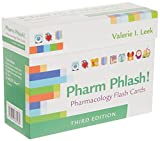
Focus on Pharmacology (8th Edition)
Focus on Nursing Pharmacology makes challenging concepts more approachable. Engaging learning features cultivate your clinical application, critical thinking and patient education capabilities. This updated 8th edition builds on your knowledge of physiology, chemistry and nursing fundamentals to help you conceptualize need-to-know information about each group of drugs.
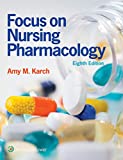
Pharmacology Made Incredibly Easy (Incredibly Easy! Series®)
Nursing pharmacology guide offers step-by-step guidance so you can grasp the fundamentals in enjoyable Incredibly Easy style. This is the perfect supplement to class materials, offering solid preparation for NCLEX® as well as a handy refresher for experienced nurses. Colorfully illustrated chapters offer clear, concise descriptions of crucial nursing pharmacology concepts and procedures.

Lehne’s Pharmacology for Nursing Care (11th Edition)
The Eleventh Edition of Lehne’s Pharmacology for Nursing Care provides a thorough understanding of key drugs and their implications for nursing care. This text, written by renowned nursing educators, helps you comprehend and apply pharmacology principles. A clear and engaging writing style simplifies complex concepts, making even the most challenging pharmacology content enjoyable. We recommend this book if you want a comprehensive nursing pharmacology guide.
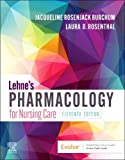
Nursing Drug Handbook
Nursing2023 Drug Handbook delivers evidence-based, nursing-focused drug monographs for nearly 3700 generic, brand-name, and combination drugs. With a tabbed, alphabetical organization and a “New Drugs” section, NDH2023 makes it easy to check drug facts on the spot.
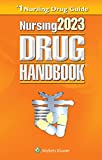
Pharmacology and the Nursing Process
The 10th edition of Pharmacology and the Nursing Process offers practical, user-friendly pharmacology information. The photo atlas contains over 100 unique illustrations and photographs depicting drug administration techniques. Updated drug content reflects the most recent FDA drug approvals, withdrawals, and therapeutic uses.
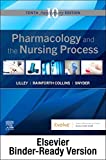
Mosby’s Pharmacology Memory NoteCards: Visual, Mnemonic, and Memory Aids for Nurses
The 6th edition of Mosby’s Pharmacology Memory NoteCards: Visual, Mnemonic, & Memory Aids for Nurses incorporates illustrations and humor to make studying easier and more enjoyable. This unique pharmacology review can be utilized as a spiral-bound notebook or as individual flashcards, making it ideal for mobile study.
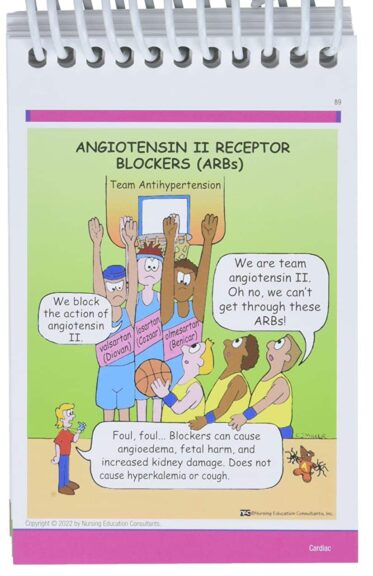
See Also
Here are other nursing pharmacology study guides:
- Nursing Pharmacology – Study Guide for Nurses
Our collection of topics related to nursing pharmacology - Pharmacology Nursing Mnemonics & Tips
These nursing mnemonics aim to simplify the concepts of pharmacology through the use of a simple, concise guide. - Generic Drug Name Stems Cheat Sheet
Learn about these generic drug name stems to help you make sense of drugs easier! - Common Drugs and Their Antidotes
A guide to drug antidotes that nurses should be familiar about. - IV Fluids and Solutions Guide & Cheat Sheet
Get to know the different types of intravenous solutions or IV fluids in this guide and cheat sheet. - Drug Dosage Calculations NCLEX Practice Questions (100+ Items)
Care to take the challenge? This quiz aims to help students and registered nurses alike grasp and master the concepts of medication calculation.
Drug Guides NEW!
Individual drug guides and nursing considerations for the most common medications used in nursing pharmacology:
- Acetaminophen (Tylenol)
- Aspirin
- Atorvastatin (Lipitor)
- Enoxaparin (Lovenox)
- Furosemide (Lasix)
- Gabapentin
- Hydromorphone (Dilaudid)
- Lisinopril
- Metoprolol
- Morphine
Gastrointestinal System Drugs
Respiratory System Drugs
- Antihistamines
- Bronchodilators and Antiasthmatics
- Decongestants
- Expectorants and Mucolytics
- Inhaled Steroids
- Lung Surfactants
Endocrine System Drugs
- Adrenocortical Agents
- Antidiabetic Agents
- Glucose-Elevating Agents
- Hypothalamic Agents
- Insulin
- Parathyroid Agents: Bisphosphonates, Calcitonins
- Pituitary Drugs
- Sulfonylureas
- Thyroid Agents
Autonomic Nervous System Drugs
- Adrenergic Agonists (Sympathomimetics)
- Adrenergic Antagonists (Sympatholytics)
- Anticholinergics (Parasympatholytics)
- Cholinergic Agonists (Parasympathomimetics)
Immune System Drugs
Chemotherapeutic Agents
- Anthelmintics
- Anti-Infective Drugs
- Antibiotics
- Antifungals
- Antineoplastic Agents
- Antiprotozoal Drugs
- Antiviral Drugs
Reproductive System Drugs
Nervous System Drugs
- Antidepressants
- Antiparkinsonism Drugs
- Antiseizure Drugs
- Anxiolytics and Hypnotic Drugs
- General and Local Anesthetics
- Muscle Relaxants
- Narcotics, Narcotic Agonists, and Antimigraine Agents
- Neuromuscular Junction Blocking Agents
- Psychotherapeutic Drugs
Cardiovascular System Drugs
References and Sources
References and sources for this pharmacology guide for Pituitary Agents:
- Karch, A. M., & Karch. (2011). Focus on nursing pharmacology. Wolters Kluwer Health/Lippincott Williams & Wilkins. [Link]
- Katzung, B. G. (2017). Basic and clinical pharmacology. McGraw-Hill Education.
- Lehne, R. A., Moore, L. A., Crosby, L. J., & Hamilton, D. B. (2004). Pharmacology for nursing care.
- Smeltzer, S. C., & Bare, B. G. (1992). Brunner & Suddarth’s textbook of medical-surgical nursing. Philadelphia: JB Lippincott.
